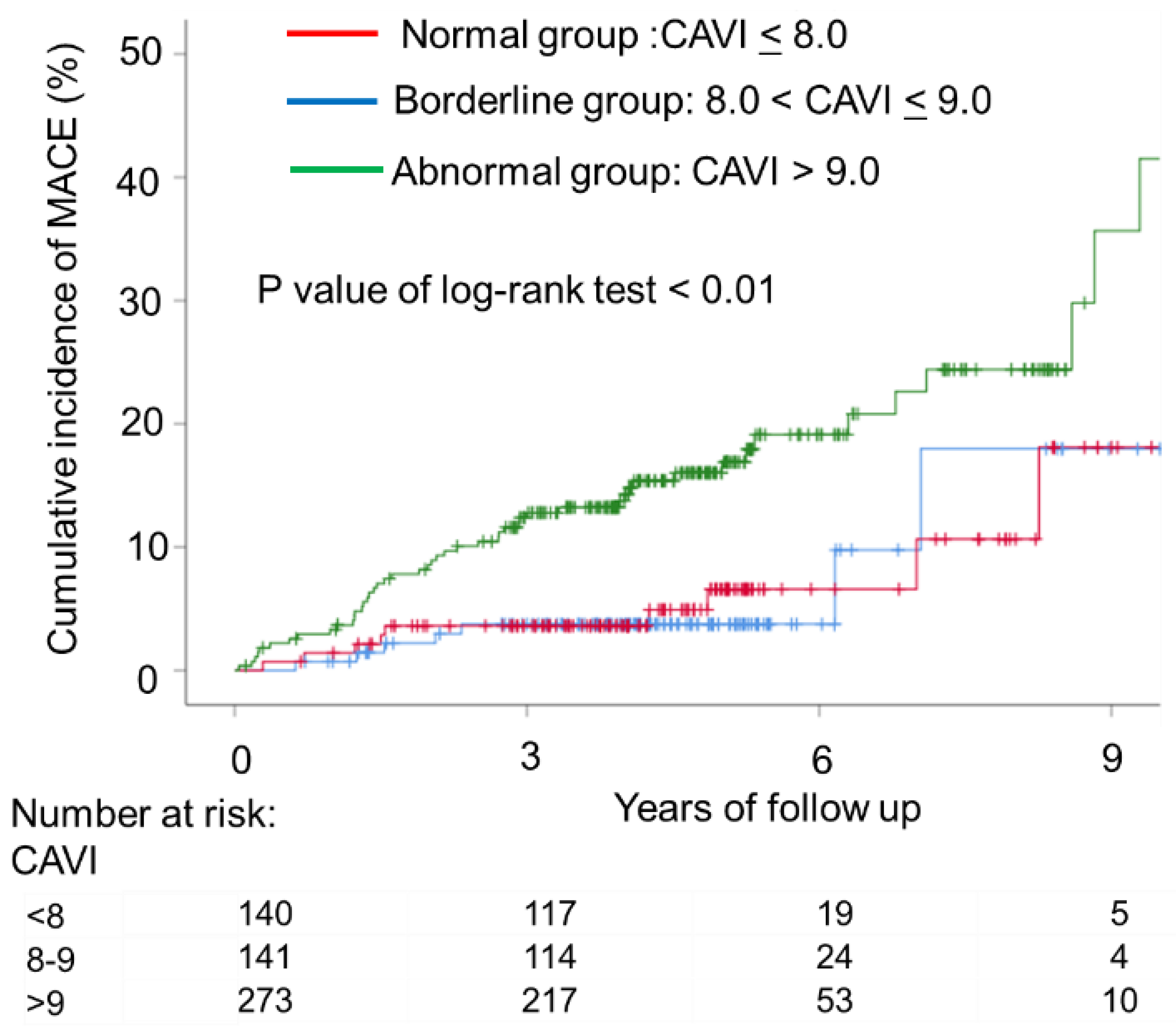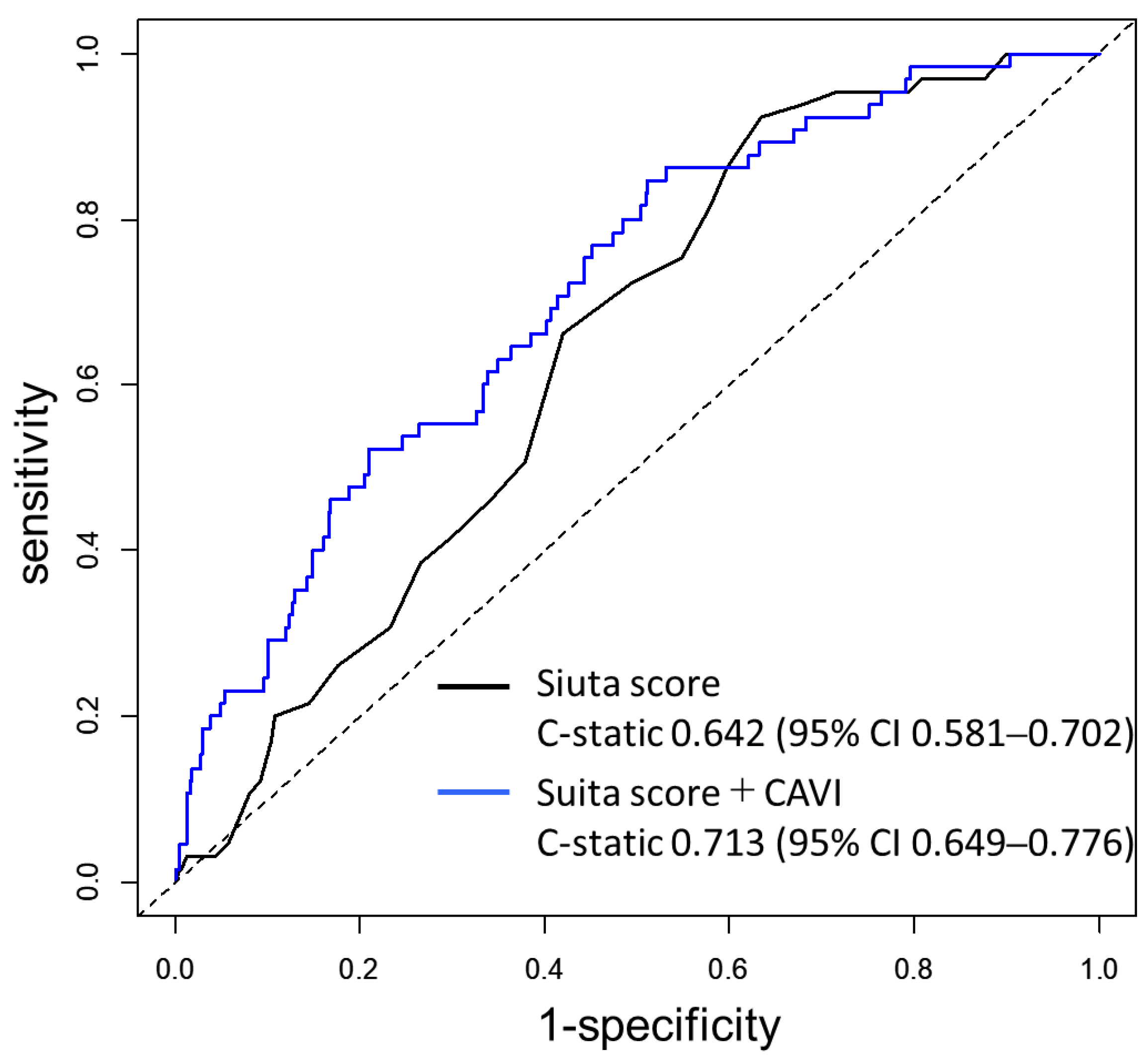Cardio-Ankle Vascular Index as an Arterial Stiffness Marker Improves the Prediction of Cardiovascular Events in Patients without Cardiovascular Diseases
Abstract
1. Introduction
2. Methods
2.1. Study Population
2.2. Measurement of CAVI
2.3. The Suita Score
2.4. Outcome Data
2.5. Statistical Analysis
3. Results
3.1. Comparison of Baseline Characteristics
3.2. Association between Cumulative Incidence of Major Adverse Cardiovascular Events (MACE) and CAVI
3.3. Incremental Predictive Value of CAVI over the Suita Score
4. Discussion
5. Conclusions
Author Contributions
Funding
Institutional Review Board Statement
Informed Consent Statement
Data Availability Statement
Conflicts of Interest
References
- Miyoshi, T.; Ito, H. Arterial stiffness in health and disease: The role of cardio-ankle vascular index. J. Cardiol. 2021, 78, 493–501. [Google Scholar] [CrossRef] [PubMed]
- Mitchell, G.F.; Hwang, S.J.; Vasan, R.S.; Larson, M.G.; Pencina, M.J.; Hamburg, N.M.; Vita, J.A.; Levy, D.; Benjamin, E.J. Arterial stiffness and cardiovascular events: The Framingham Heart Study. Circulation 2010, 121, 505–511. [Google Scholar] [CrossRef] [PubMed]
- Chirinos, J.A.; Segers, P.; Hughes, T.; Townsend, R. Large-artery stiffness in health and disease: JACC state-of-the-art review. J. Am. Coll. Cardiol. 2019, 74, 1237–1263. [Google Scholar] [CrossRef] [PubMed]
- Shirai, K.; Utino, J.; Otsuka, K.; Takata, M. A novel blood pressure-independent arterial wall stiffness parameter; cardio-ankle vascular index (CAVI). J. Atheroscler. Thromb. 2006, 13, 101–107. [Google Scholar] [CrossRef] [PubMed]
- Kubota, Y.; Maebuchi, D.; Takei, M.; Inui, Y.; Sudo, Y.; Ikegami, Y.; Fuse, J.; Sakamoto, M.; Momiyama, Y. Cardio-Ankle Vascular Index is a predictor of cardiovascular events. Artery Res. 2011, 5, 91–96. [Google Scholar] [CrossRef]
- Miyoshi, T.; Ito, H.; Shirai, K.; Horinaka, S.; Higaki, J.; Yamamura, S.; Saiki, A.; Takahashi, M.; Masaki, M.; Okura, T.; et al. Predictive value of the cardio-ankle vascular index for cardiovascular events in patients at cardiovascular risk. J. Am. Heart Assoc. 2021, 10, e020103. [Google Scholar] [CrossRef]
- Gohbara, M.; Iwahashi, N.; Sano, Y.; Akiyama, E.; Maejima, N.; Tsukahara, K.; Hibi, K.; Kosuge, M.; Ebina, T.; Umemura, S.; et al. Clinical impact of the cardio-ankle vascular index for predicting cardiovascular events after acute coronary syndrome. Circ. J. 2016, 80, 1420–1426. [Google Scholar] [CrossRef]
- Sumin, A.N.; Shcheglova, A.V.; Zhidkova, I.I.; Ivanov, S.V.; Barbarash, O.L. Assessment of arterial stiffness by cardio-ankle vascular index for prediction of five-year cardiovascular events after coronary artery bypass surgery. Glob. Heart 2021, 16, 90. [Google Scholar] [CrossRef]
- Kirigaya, J.; Iwahashi, N.; Tahakashi, H.; Minamimoto, Y.; Gohbara, M.; Abe, T.; Akiyama, E.; Okada, K.; Matsuzawa, Y.; Maejima, N.; et al. Impact of cardio-ankle vascular index on long-term outcome in patients with acute coronary syndrome. J. Atheroscler. Thromb. 2020, 27, 657–668. [Google Scholar] [CrossRef]
- Chung, S.L.; Yang, C.C.; Chen, C.C.; Hsu, Y.C.; Lei, M.H. Coronary artery calcium score compared with cardio-ankle vascular index in the prediction of cardiovascular events in asymptomatic patients with Type 2 diabetes. J. Atheroscler. Thromb. 2015, 22, 1255–1265. [Google Scholar] [CrossRef]
- Kusunose, K.; Sato, M.; Yamada, H.; Saijo, Y.; Bando, M.; Hirata, Y.; Nishio, S.; Hayashi, S.; Sata, M. Prognostic implications of non-invasive vascular function tests in high-risk atherosclerosis patients. Circ. J. 2016, 80, 1034–1040. [Google Scholar] [CrossRef]
- Laucevičius, A.; Ryliškytė, L.; Balsytė, J.; Badarienė, J.; Puronaitė, R.; Navickas, R.; Solovjova, S. Association of cardio-ankle vascular index with cardiovascular risk factors and cardiovascular events in metabolic syndrome patients. Medicina 2015, 51, 152–158. [Google Scholar] [CrossRef]
- Sato, Y.; Nagayama, D.; Saiki, A.; Watanabe, R.; Watanabe, Y.; Imamura, H.; Yamaguchi, T.; Ban, N.; Kawana, H.; Nagumo, A.; et al. Cardio-ankle vascular index is independently associated with future cardiovascular events in outpatients with metabolic disorders. J. Atheroscler. Thromb. 2016, 23, 596–605. [Google Scholar] [CrossRef]
- Limpijankit, T.; Vathesatogkit, P.; Matchariyakul, D.; Yingchoncharoen, T.; Siriyotha, S.; Thakkinstian, A.; Sritara, P. Cardio-ankle vascular index as a predictor of major adverse cardiovascular events in metabolic syndrome patients. Clin. Cardiol. 2021, 44, 1628–1635. [Google Scholar] [CrossRef]
- Yasuharu, T.; Setoh, K.; Kawaguchi, T.; Nakayama, T.; Matsuda, F.; Nagahama study group. Brachial-ankle pulse wave velocity and cardio-ankle vascular index are associated with future cardiovascular events in a general population: The Nagahama Study. J. Clin. Hypertens. 2021, 23, 1390–1398. [Google Scholar] [CrossRef]
- Satoh-Asahara, N.; Kotani, K.; Yamakage, H.; Yamada, T.; Araki, R.; Okajima, T.; Adachi, M.; Oishi, M.; Shimatsu, A.; Japan Obesity and Metabolic Syndrome Study (JOMS) Group. Cardio-ankle vascular index predicts for the incidence of cardiovascular events in obese patients: A multicenter prospective cohort study (Japan Obesity and Metabolic Syndrome Study: JOMS). Atherosclerosis 2015, 242, 461–468. [Google Scholar] [CrossRef]
- Tanaka, A.; Tomiyama, H.; Maruhashi, T.; Matsuzawa, Y.; Miyoshi, T.; Kabutoya, T.; Kario, K.; Sugiyama, S.; Munakata, M.; Ito, H.; et al. Physiological diagnostic criteria for vascular failure. Hypertension 2018, 72, 1060–1071. [Google Scholar] [CrossRef]
- Arnett, D.K.; Blumenthal, R.S.; Albert, M.A.; Buroker, A.B.; Goldberger, Z.D.; Hahn, E.J.; Himmelfarb, C.D.; Khera, A.; Lloyd-Jones, D.; McEvoy, J.W.; et al. 2019 ACC/AHA Guideline on the Primary Prevention of Cardiovascular Disease: Executive Summary: A Report of the American College of Cardiology/American Heart Association Task Force on Clinical Practice Guidelines. J. Am. Coll. Cardiol. 2019, 74, 1376–1414. [Google Scholar] [CrossRef]
- SCORE2 working group and ESC Cardiovascular risk collaboration. SCORE2 risk prediction algorithms: New models to estimate 10-year risk of cardiovascular disease in Europe. Eur. Heart J. 2021, 42, 2439–2454. [Google Scholar] [CrossRef]
- Nishimura, K.; Okamura, T.; Watanabe, M.; Nakai, M.; Takegami, M.; Higashiyama, A.; Kokubo, Y.; Okayama, A.; Miyamoto, Y. Predicting coronary heart disease using risk factor categories for a Japanese urban population, and comparison with the Framingham risk score: The suita study. J. Atheroscler. Thromb. 2014, 21, 784–798. [Google Scholar] [CrossRef]
- Matsuo, S.; Imai, E.; Horio, M.; Yasuda, Y.; Tomita, K.; Nitta, K.; Yamagata, K.; Tomino, Y.; Yokoyama, H.; Hishida, A.; et al. Revised equations for estimated GFR from serum creatinine in Japan. Am. J. Kidney Dis. 2009, 53, 982–992. [Google Scholar] [CrossRef] [PubMed]



| All | Normal CAVI | Borderline CAVI | Abnormal CAVI | ||
|---|---|---|---|---|---|
| (CAVI < 8) | (8 ≤ CAVI < 9) | (9 ≤ CAVI) | |||
| Variables | (n = 554) | (n = 140) | (n = 141) | (n = 273) | p-Value for Trend |
| Age, year | 66 ± 9 | 62 ± 10 | 67 ± 9 | 71 ± 7 | <0.01 |
| Male, n (%) | 353 (64) | 92 (66) | 76 (54) | 185 (68) | 0.01 |
| Body mass index, kg/m2 | 23.4 ± 3.9 | 24.7 ± 4.6 | 23.9 ± 3.8 | 22.9 ± 3.5 | <0.01 |
| Hypertension, n (%) | 418 (75) | 84 (60) | 110 (78) | 224 (82) | <0.01 |
| Diabetes mellitus, n (%) | 283 (51) | 69 (43) | 76 (54) | 138 (51) | 0.72 |
| Dyslipidemia, n (%) | 343 (62) | 82 (59) | 92 (65) | 169 (62) | 0.52 |
| Current smoking, n (%) | 159 (29) | 44 (31) | 41 (29) | 74 (27) | 0.65 |
| Systolic blood pressure, mmHg | 129 ± 19 | 122 ± 19 | 128 ± 16 | 133 ± 18 | <0.01 |
| Diastolic blood pressure, mmHg | 74 ± 11 | 72 ± 11 | 74 ± 10 | 75 ± 11 | 0.04 |
| Laboratory data | |||||
| Triglyceride, mg/dL | 140 ± 119 | 136 ± 126 | 137 ± 94 | 144 ± 126 | 0.78 |
| HDL-C, mg/dL | 55 ± 17 | 58 ± 19 | 54 ± 18 | 545 ± 16 | 0.08 |
| LDL-C, mg/dL | 109 ± 31 | 113 ± 33 | 110 ± 31 | 107 ± 32 | 0.17 |
| HemoglobinA1c, % | 6.4 ± 1.4 | 6.3 ± 1.5 | 6.5 ± 1.4 | 6.5 ± 1.4 | 0.69 |
| eGFR, mL/min/1.73 m2 | 66.1 ± 19.4 | 70.0 ± 17.3 | 68.0 ± 20.9 | 63.3 ± 18.2 | 0.02 |
| Medications | |||||
| Antihypertensive agents, n (%) | 406 (73) | 85 (61) | 107 (76) | 214 (78) | <0.01 |
| Antidiabetic agents, n (%) | 178 (42) | 34 (37) | 52(47) | 92 (42) | 0.31 |
| Lipid-lowering agents, n (%) | 310 (56) | 64 (46) | 86 (61) | 160 (59) | 0.01 |
| Univariate | Multivariate | |||
|---|---|---|---|---|
| HR (95% CI) | p-Value | HR (95% CI) | p-Value | |
| CAVI > 9 | 3.07 (1.78–5.41) | <0.01 | 2.31 (1.27–4.18) | <0.01 |
| Age per year | 1.05 (1.01–1.08) | <0.01 | 1.02 (0.98–1.06) | 0.18 |
| Male | 1.97 (1.09–3.57) | 0.02 | 1.86 (1.02–3.39) | 0.04 |
| Hypertension | 2.56 (1.16–5.62) | 0.01 | 0.86 (0.38–2.27) | 0.86 |
| Diabetes mellitus | 1.44 (0.87–2.37) | 0.14 | ||
| Dyslipidemia | 1.68 (0.96–2.93) | 0.06 | ||
| Current smoking | 1.34 (0.80–2.25) | 0.25 | ||
| Antihypertensive agents | 5.36 (1.94–14.78) | <0.01 | 4.16 (1.29–13.40) | 0.01 |
| Antidiabetic agents | 1.41 (0.32–2.40) | 0.20 | ||
| Lipid-lowering agents | 1.79 (1.05–3.07) | 0.03 | 1.56 (0.91–2.68) | 0.10 |
Publisher’s Note: MDPI stays neutral with regard to jurisdictional claims in published maps and institutional affiliations. |
© 2022 by the authors. Licensee MDPI, Basel, Switzerland. This article is an open access article distributed under the terms and conditions of the Creative Commons Attribution (CC BY) license (https://creativecommons.org/licenses/by/4.0/).
Share and Cite
Okamoto, Y.; Miyoshi, T.; Ichikawa, K.; Takaya, Y.; Nakamura, K.; Ito, H. Cardio-Ankle Vascular Index as an Arterial Stiffness Marker Improves the Prediction of Cardiovascular Events in Patients without Cardiovascular Diseases. J. Cardiovasc. Dev. Dis. 2022, 9, 368. https://doi.org/10.3390/jcdd9110368
Okamoto Y, Miyoshi T, Ichikawa K, Takaya Y, Nakamura K, Ito H. Cardio-Ankle Vascular Index as an Arterial Stiffness Marker Improves the Prediction of Cardiovascular Events in Patients without Cardiovascular Diseases. Journal of Cardiovascular Development and Disease. 2022; 9(11):368. https://doi.org/10.3390/jcdd9110368
Chicago/Turabian StyleOkamoto, Yuko, Toru Miyoshi, Keishi Ichikawa, Yoichi Takaya, Kazufumi Nakamura, and Hiroshi Ito. 2022. "Cardio-Ankle Vascular Index as an Arterial Stiffness Marker Improves the Prediction of Cardiovascular Events in Patients without Cardiovascular Diseases" Journal of Cardiovascular Development and Disease 9, no. 11: 368. https://doi.org/10.3390/jcdd9110368
APA StyleOkamoto, Y., Miyoshi, T., Ichikawa, K., Takaya, Y., Nakamura, K., & Ito, H. (2022). Cardio-Ankle Vascular Index as an Arterial Stiffness Marker Improves the Prediction of Cardiovascular Events in Patients without Cardiovascular Diseases. Journal of Cardiovascular Development and Disease, 9(11), 368. https://doi.org/10.3390/jcdd9110368








